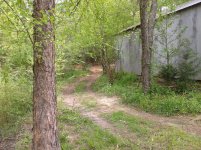MossflowerWoods
Super Member
- Joined
- Aug 12, 2011
- Messages
- 5,419
- Location
- Fredericksburg, VA
- Tractor
- Kioti DK50SE HST w/FEL, Gravely 60" ZTR Mower. Stihl MS290 (selling), CS261, & FS190 + Echo CS400 & 2010 F-350 6.4 PSD snowplow truck
Guys,
I am trying to rebuild an old and overgrown tractor road. Clearly I have a bigger tractor than the other guy had and I'm having issues.
My biggest problem is that I have wet spots. The ground slopes and the road runs alongside a pond. when it is dry and has been for a while the road is awesome. if it has rained, Oh Golly! it turns to serious mud and the tractor tears it up, digs ruts and makes a mess. To top it off, the part in the picture, right by the "barn" is not level, it slopes towards the pond.
I really would like this to work. It is the only way to get access to park the tractor in the barn where my hay etc is stored without tearing up part of the "yard" with a tractor road.
I have added some fill to the low spots, and I though maybe it was dry again, and I tried to backdrag it smooth and all I got was deep muddy ruts.
Do I need to add gravel? I can add tons of pine straw and or leaes or other organic material to soak up water, but I suspect that will be worse.
I do not have a "stream" I can cut a culvert for to divert the water, this is more like seepage and I have 3 distinct "wet spots".
Thanks in advance,
David
I am trying to rebuild an old and overgrown tractor road. Clearly I have a bigger tractor than the other guy had and I'm having issues.
My biggest problem is that I have wet spots. The ground slopes and the road runs alongside a pond. when it is dry and has been for a while the road is awesome. if it has rained, Oh Golly! it turns to serious mud and the tractor tears it up, digs ruts and makes a mess. To top it off, the part in the picture, right by the "barn" is not level, it slopes towards the pond.
I really would like this to work. It is the only way to get access to park the tractor in the barn where my hay etc is stored without tearing up part of the "yard" with a tractor road.
I have added some fill to the low spots, and I though maybe it was dry again, and I tried to backdrag it smooth and all I got was deep muddy ruts.
Do I need to add gravel? I can add tons of pine straw and or leaes or other organic material to soak up water, but I suspect that will be worse.
I do not have a "stream" I can cut a culvert for to divert the water, this is more like seepage and I have 3 distinct "wet spots".
Thanks in advance,
David

